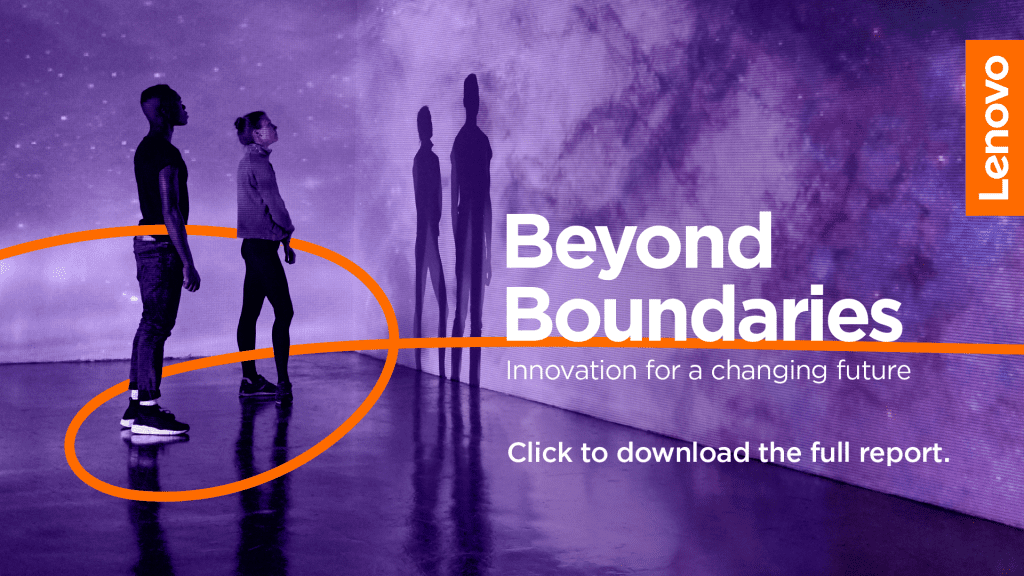“COVID drove a massive acceleration. How can we move faster? It drove a sense of urgency. Remote medicine had been talked about for years. Suddenly it was implemented in days.”
– Daryl Cromer, CTO of PCs and Smart Devices at Lenovo
It’s commonly understood that time equals progress, that we have been on an upwards curve of technological and societal development since the Renaissance. Yet there are certain periods in history where this development is accelerated. Such that, when viewed retrospectively, they emerge as distinct and shining layers of progress in the strata of our history.
There is a growing sense that this last year, and indeed the years following, will emerge as such a period. The global pandemic has necessarily transformed the way our society operates and innovates. Unprecedented levels of global co-operation allowed a COVID-19 vaccine to be developed at record speed. After years of debating the merits and feasibility of remote working, many businesses quickly pivoted to a model in which a large proportion of their employees were working from home.
At Lenovo, we faced up to the significant challenge of coordinating our factory and supply chain operations in the eye of the storm. We had to innovate to make sure our customers and consumers remained well stocked at a time when society was relying on technology more than ever. In the process both business and society demonstrated innovation beyond what we once understood as boundaries.
Of course, innovating beyond boundaries is something that has always been at the core of our business at Lenovo. A significant part of this is innovating beyond geographical boundaries. We’re a multinational unlike any other, with 15 R&D sites across China, Japan and the USA, and 34 manufacturing sites in Argentina, Brazil, China, Germany, Hungary, India, Japan, Mexico, USA.
Our workforce comprises 71,500 members of the Lenovo family globally, collaborating in over a hundred different languages. No mean feat. But we also pride ourselves on innovating beyond cultural boundaries. The design of our iconic ThinkPad, used by people around the globe, was famously inspired by the Japanese bento box. Seeing how the global pandemic accelerated these practices and attitudes within Lenovo, we set out to understand the experience of other global businesses – at least in part to accelerate our own innovation as we continue our service led transformation. Earlier this year, we commissioned research among 300 business leaders worldwide to understand the strategic drivers, approaches to and challenges around innovation within their organizations. We also spoke in-depth to a number of industry experts, from product and manufacturing specialists within Lenovo to leaders in the financial services and retail sectors.
We found that as businesses look to the post-COVID future, they are ready to innovate – not just to satisfy pent-up demand and unlock growth, but also to improve their social and environmental performance. Two in three businesses (67%) believe their response to COVID-19 has ultimately made them more innovative and agile, and 54% say the crisis has catalyzed their efforts to use innovation to improve their social and environmental performance – with sustainability the top innovation driver.
Yet there are also clear challenges, 61% stated that they want to get better at innovation but don’t know how, while over half (55%) say their employees lost the drive to innovate at some point during the crisis, due to personal pressures.
Ultimately, our research suggests that businesses need to hit three milestones before they can achieve an innovation culture: deliver on the promise of a global diverse workforce; find and replace the legacy behaviors that undermine innovation; and make technology an enabler of culture. It is only then that firms can deliver on the opportunities offered by this period of accelerated innovation.
Our Product Diversity Office is a prime example of these principles in action, enabling employees of all levels to sell innovative ideas to senior leadership. Partnering with pioneering individuals like Haben Girma, the first deafblind graduate of Harvard Law School who has become a leading disability rights activist, helps us to break up the old ways of working and build new, improved versions.
And here, perhaps, is the most crucial point of all. To make the most of this pivotal point in history, paying lip service will not cut it. It is high time we all stopped talking and started doing.
Read the Beyond Boundaries report in full, detailing the findings.

